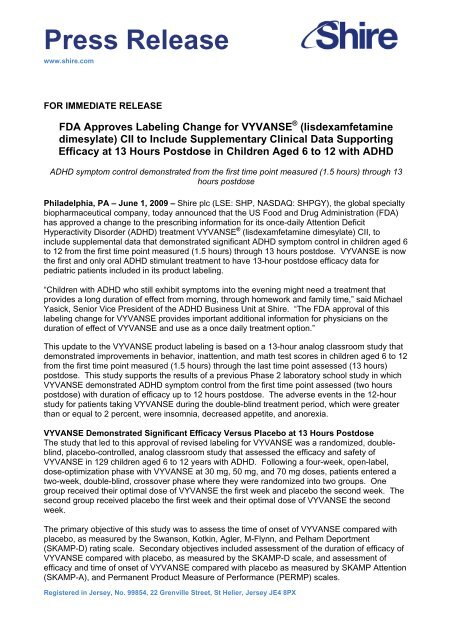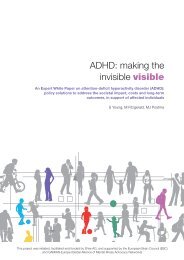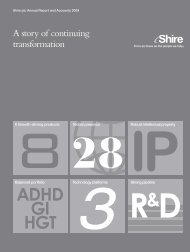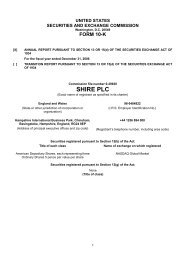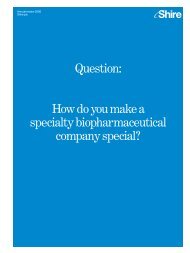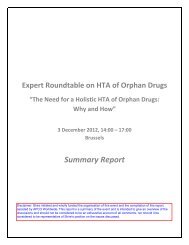You also want an ePaper? Increase the reach of your titles
YUMPU automatically turns print PDFs into web optimized ePapers that Google loves.
<strong>Press</strong> <strong>Release</strong><br />
www.shire.com<br />
FOR IMMEDIATE RELEASE<br />
FDA Approves Labeling Change for VYVANSE ® (lisdexamfetamine<br />
dimesylate) CII to Include Supplementary Clinical Data Supporting<br />
Efficacy at 13 Hours Postdose in Children Aged 6 to 12 with ADHD<br />
ADHD symptom control demonstrated from the first time point measured (1.5 hours) through 13<br />
hours postdose<br />
Philadelphia, PA – June 1, 2009 – <strong>Shire</strong> plc (LSE: SHP, NASDAQ: SHPGY), the global specialty<br />
biopharmaceutical company, today announced that the US Food and Drug Administration (FDA)<br />
has approved a change to the prescribing information for its once-daily Attention Deficit<br />
Hyperactivity Disorder (ADHD) treatment VYVANSE ® (lisdexamfetamine dimesylate) CII, to<br />
include supplemental data that demonstrated significant ADHD symptom control in children aged 6<br />
to 12 from the first time point measured (1.5 hours) through 13 hours postdose. VYVANSE is now<br />
the first and only oral ADHD stimulant treatment to have 13-hour postdose efficacy data for<br />
pediatric patients included in its product labeling.<br />
“Children with ADHD who still exhibit symptoms into the evening might need a treatment that<br />
provides a long duration of effect from morning, through homework and family time,” said Michael<br />
Yasick, Senior Vice President of the ADHD Business Unit at <strong>Shire</strong>. “The FDA approval of this<br />
labeling change for VYVANSE provides important additional information for physicians on the<br />
duration of effect of VYVANSE and use as a once daily treatment option.”<br />
This update to the VYVANSE product labeling is based on a 13-hour analog classroom study that<br />
demonstrated improvements in behavior, inattention, and math test scores in children aged 6 to 12<br />
from the first time point measured (1.5 hours) through the last time point assessed (13 hours)<br />
postdose. This study supports the results of a previous Phase 2 laboratory school study in which<br />
VYVANSE demonstrated ADHD symptom control from the first time point assessed (two hours<br />
postdose) with duration of efficacy up to 12 hours postdose. The adverse events in the 12-hour<br />
study for patients taking VYVANSE during the double-blind treatment period, which were greater<br />
than or equal to 2 percent, were insomnia, decreased appetite, and anorexia.<br />
VYVANSE Demonstrated Significant Efficacy Versus Placebo at 13 Hours Postdose<br />
The study that led to this approval of revised labeling for VYVANSE was a randomized, doubleblind,<br />
placebo-controlled, analog classroom study that assessed the efficacy and safety of<br />
VYVANSE in 129 children aged 6 to 12 years with ADHD. Following a four-week, open-label,<br />
dose-optimization phase with VYVANSE at 30 mg, 50 mg, and 70 mg doses, patients entered a<br />
two-week, double-blind, crossover phase where they were randomized into two groups. One<br />
group received their optimal dose of VYVANSE the first week and placebo the second week. The<br />
second group received placebo the first week and their optimal dose of VYVANSE the second<br />
week.<br />
The primary objective of this study was to assess the time of onset of VYVANSE compared with<br />
placebo, as measured by the Swanson, Kotkin, Agler, M-Flynn, and Pelham Deportment<br />
(SKAMP-D) rating scale. Secondary objectives included assessment of the duration of efficacy of<br />
VYVANSE compared with placebo, as measured by the SKAMP-D scale, and assessment of<br />
efficacy and time of onset of VYVANSE compared with placebo as measured by SKAMP Attention<br />
(SKAMP-A), and Permanent Product Measure of Performance (PERMP) scales.<br />
Registered in Jersey, No. 99854, 22 Grenville Street, St Helier, Jersey JE4 8PX
In the study, VYVANSE demonstrated significant efficacy versus placebo at 1.5 hours, the first<br />
time point measured. Further, VYVANSE treatment was associated with significant efficacy as<br />
measured by both subjective (SKAMP-D and SKAMP-A) and objective (PERMP) assessments<br />
from the first time point (1.5 hours) through the last time point (13 hours) assessed during the<br />
classroom day, and at all time points in between (2.5, 5.0, 7.5, 10.0 and 12.0 hours).<br />
Safety was also evaluated during the study. The most frequently reported adverse events (greater<br />
than or equal to 10 percent and twice placebo) in the dose optimization phase for patients taking<br />
VYVANSE were decreased appetite, insomnia, headache, irritability, upper abdominal pain, and<br />
affect lability (mood swings).<br />
VYVANSE, which was introduced in the United States in July 2007 for the treatment of ADHD in<br />
children aged 6 to 12 years and approved in April 2008 to treat ADHD in adults, is currently<br />
available in six dosage strengths of 20 mg, 30 mg, 40 mg, 50 mg, 60 mg, and 70 mg. To date,<br />
more than 5 million VYVANSE prescriptions have been filled, bringing the current market share to<br />
12 percent based on weekly branded prescription volume. Additionally, VYVANSE formulary<br />
coverage has been positive, with 10 of 11 top managed care plans covering the product in a<br />
preferred formulary position.<br />
VYVANSE is a therapeutically inactive prodrug, in which d-amphetamine is covalently bonded to<br />
l-lysine, and after oral ingestion it is converted to pharmacologically active d-amphetamine. The<br />
conversion of VYVANSE to d-amphetamine is not affected by gastrointestinal pH and is unlikely to<br />
be affected by alterations in GI transit times.<br />
Additional information about VYVANSE and Full Prescribing Information, including Medication<br />
Guide, are available at www.vyvanse.com.<br />
For further information please contact:<br />
Investor Relations Cléa Rosenfeld (<strong>Shire</strong> Rest of the World) +44 1256 894 160<br />
Eric Rojas (<strong>Shire</strong> North America) +1 617 551 9715<br />
Media Matthew Cabrey (<strong>Shire</strong> North America) +1 484 595 8248<br />
Mindy Huber (Porter Novelli for <strong>Shire</strong>) +1 212 601 8330<br />
Notes to Editor<br />
The Swanson, Kotkin, Agler, M-Flynn, and Pelham Deportment (SKAMP-D) scale is a<br />
standardized, validated classroom assessment tool used for evaluating the behavioral symptoms<br />
of ADHD and higher SKAMP-D ratings reflecting greater impairment.<br />
The Permanent Product Measure of Performance (PERMP) is an age-adjusted collection of math<br />
problems that provides an objective measure of performance based on the number of attempted<br />
and completed math problems.<br />
About VYVANSE<br />
Vyvanse is indicated for the treatment of ADHD. Efficacy based on two controlled trials in children<br />
aged 6 to 12 and one controlled trial in adults.<br />
Tell the doctor about any heart conditions, including structural abnormalities, that you,<br />
your child, or a family member, may have. Inform the doctor immediately if you or your child<br />
develops symptoms that suggest heart problems, such as chest pain or fainting.<br />
Vyvanse should not be taken if you or your child has advanced disease of the blood vessels<br />
(arteriosclerosis); symptomatic heart disease; moderate to severe high blood pressure; overactive
thyroid gland (hyperthyroidism); known allergy or unusual reactions to drugs called<br />
sympathomimetic amines (for example, pseudoephedrine); seizures; glaucoma; a history of<br />
problems with alcohol or drugs; agitated states; taken a monoamine oxidase inhibitor (MAOI)<br />
within the last 14 days.<br />
Tell the doctor before taking Vyvanse if you or your child is being treated for or has symptoms of<br />
depression (sadness, worthlessness, or hopelessness) or bipolar disorder; has abnormal thought<br />
or visions, hears abnormal sounds, or has been diagnosed with psychosis; has had seizures or<br />
abnormal EEGs; has or has had high blood pressure; exhibits aggressive behavior or hostility.<br />
Tell the doctor immediately if you or your child develops any of these conditions or symptoms<br />
while taking Vyvanse.<br />
Abuse of amphetamines may lead to dependence. Misuse of amphetamine may cause<br />
sudden death and serious cardiovascular adverse events. These events have also been<br />
reported rarely with amphetamine use.<br />
Talk to your health care provider if your child experiences slowing of growth (height and weight).<br />
Children should have their height and weight checked periodically while taking Vyvanse. Your<br />
healthcare provider may stop Vyvanse treatment if a problem is found during these check-ups.<br />
Vyvanse was generally well tolerated in clinical studies. The most common side effects reported<br />
in studies of Vyvanse were: children – decreased appetite, difficulty falling asleep, stomachache,<br />
and irritability; adult – decreased appetite, difficulty falling asleep, and dry mouth.<br />
Aggression, new abnormal thoughts/behaviors, mania, growth suppression, worsening of motion<br />
or verbal tics, and Tourette’s syndrome have been associated with use of drugs of this type. Tell<br />
the doctor if you or your child has blurred vision while taking Vyvanse.<br />
About ADHD<br />
ADHD is one of the most common psychiatric disorders in children and adolescents. Worldwide<br />
prevalence of ADHD is estimated at 5.3 percent (with large variability), according to a<br />
comprehensive systematic review of this topic published in 2007 in the American Journal of<br />
Psychiatry. In the United States, approximately 7.8 percent of all school-aged children, or about<br />
4.4 million children aged 4 to 17 years, have been diagnosed with ADHD at some point in their<br />
lives, according to the Centers for Disease Control and Prevention (CDC). The disorder is also<br />
estimated to affect 4.4 percent of US adults aged 18 to 44 based on results from the National<br />
Comorbidity Survey Replication. When this percentage is extrapolated to the full US population<br />
aged 18 and over, approximately 9.8 million adults are believed to have ADHD.<br />
ADHD is a psychiatric behavioral disorder that manifests as a persistent pattern of inattention<br />
and/or hyperactivity-impulsivity that is more frequent and severe than is typically observed in<br />
individuals at a comparable level of development. The specific etiology of ADHD is unknown and<br />
there is no single diagnostic test for this syndrome. Adequate diagnosis requires the use of<br />
medical and special psychological, educational and social resources, utilizing diagnostic criteria<br />
such as Diagnostic and Statistical Manual of Mental Disorders-IV (DSM-IV-TR) or International<br />
Classification of Diseases 10 (ICD-10).<br />
Although there is no “cure” for ADHD, there are accepted treatments that specifically target its<br />
symptoms. Standard treatments include educational approaches, psychological, or behavioral<br />
modification, and medication.<br />
SHIRE PLC<br />
<strong>Shire</strong>’s strategic goal is to become the leading specialty biopharmaceutical company that focuses<br />
on meeting the needs of the specialist physician. <strong>Shire</strong> focuses its business on attention deficit<br />
hyperactivity disorder (ADHD), human genetic therapies (HGT) and gastrointestinal (GI) diseases<br />
as well as opportunities in other therapeutic areas to the extent they arise through acquisitions.<br />
<strong>Shire</strong>’s in-licensing, merger and acquisition efforts are focused on products in specialist markets
with strong intellectual property protection and global rights. <strong>Shire</strong> believes that a carefully<br />
selected and balanced portfolio of products with strategically aligned and relatively small-scale<br />
sales forces will deliver strong results.<br />
For further information on <strong>Shire</strong>, please visit the Company’s website: www.shire.com.<br />
THE “SAFE HARBOR” STATEMENT UNDER THE PRIVATE SECURITIES LITIGATION<br />
REFORM ACT OF 1995<br />
Statements included herein that are not historical facts are forward-looking statements. Such<br />
forward-looking statements involve a number of risks and uncertainties and are subject to change<br />
at any time. In the event such risks or uncertainties materialize, the Company’s results could be<br />
materially adversely affected. The risks and uncertainties include, but are not limited to, risks<br />
associated with: the inherent uncertainty of research, development, approval, reimbursement,<br />
manufacturing and commercialization of the Company’s Specialty Pharmaceutical and Human<br />
Genetic Therapies products, as well as the ability to secure and integrate new products for<br />
commercialization and/or development; government regulation of the Company’s products; the<br />
Company’s ability to manufacture its products in sufficient quantities to meet demand; the impact<br />
of competitive therapies on the Company’s products; the Company’s ability to register, maintain<br />
and enforce patents and other intellectual property rights relating to its products; the Company’s<br />
ability to obtain and maintain government and other third-party reimbursement for its products; and<br />
other risks and uncertainties detailed from time to time in the Company’s filings with the Securities<br />
and Exchange Commission.


